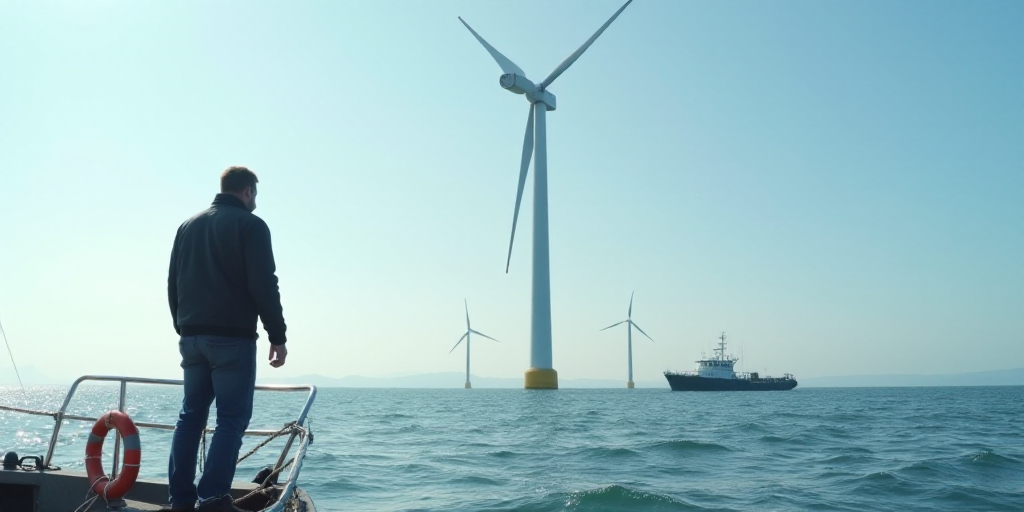Introduction
Near a small fishing port in southwestern Japan, the white blades of the country’s first commercial-scale floating wind turbine plant are now visible. This project, set to begin in the coming months, is a crucial step for Japan’s strategy in green energy, with the goal of making renewables its primary energy source by 2040 and achieving carbon neutrality a decade later.
Why Floating Turbines are Beneficial for Japan
Japan, heavily reliant on imported fossil fuels and prone to natural disasters, sees floating wind turbines as a promising solution. According to Ushigami, head of renewable marine energy at construction firm Toda, these floating structures are relatively stable even in the face of earthquakes and typhoons.
Project Details
- Eight turbines, located five kilometers off the coast of Japan’s Goto Islands in waters up to 140 meters deep, will start operating in January.
- These turbines are expected to help Japan meet its new energy goals, where the contribution from wind power needs to rise from 1% currently to between 4% and 8%.
Challenges Ahead
Despite the benefits, Japan’s path to reducing its dependence on fossil fuels remains long. In 2024, 65% of Japan’s electricity needs were met by thermal plants using coal and hydrocarbons, while only a quarter came from renewable sources, according to the Sustainable Energy Policy Institute.
- Project costs are rising, and in late August, Japanese conglomerate Mitsubishi withdrew from three wind energy projects it deemed unprofitable.
- Other operators have called for more government support, citing issues with the current bidding system that failed to anticipate rapid inflation after winning projects were selected.
Yoko Mulholland from the E3G research center emphasized that simplifying regulatory processes and easing construction restrictions would expedite project execution and reduce capital expenditures.
Hidenori Yonekura from the New Energy and Industrial Technology Development Organization highlighted that floating wind energy is a path to reducing installation costs by deploying more turbines across Japan’s vast Exclusive Economic Zone, spanning 4.5 million square kilometers.
However, achieving the 2040 wind energy targets requires installing around 200 turbines annually, each with a capacity of 15 megawatts. The challenge lies in the lack of domestic turbine manufacturers and large production sites, as Yonekura pointed out.
Involvement of Local Fishermen
Construction companies face technical challenges with these systems. Defects in the floating structure of a Goto wind turbine led Toda to replace parts, causing a two-year delay in the project.
Coexistence with local industries, especially fishing, is crucial. Toda conducted an environmental assessment and found a pilot project with “no negative impact on fishing,” ensuring local fishermen’s participation through income sharing from electricity sales, property taxes, and employment opportunities monitoring the site with their vessels.
Takuya Eashiro, head of the Fukue fishing cooperative in Goto, acknowledged that fishermen understand the project’s importance for Japan. However, the National Federation of Fisheries Cooperative Associations protested to the government after Mitsubishi’s withdrawal, reminding them that many fishermen had hoped for economic benefits from working on these projects.
Eashiro mentioned that some fishermen hope their children or grandchildren will find jobs in turbine maintenance as traditional fishing becomes less viable due to rising sea temperatures.
Key Questions and Answers
- What are floating wind turbines? Floating wind turbines are offshore wind farms built on floating platforms, allowing them to operate in deeper waters than fixed-bottom turbines.
- Why are they beneficial for Japan? Due to its vulnerability to natural disasters and heavy reliance on fossil fuel imports, Japan sees floating turbines as a stable and promising renewable energy source.
- What challenges does Japan face in adopting floating wind turbines? Rising project costs, regulatory hurdles, and the lack of domestic turbine manufacturers pose significant challenges.
- How are local fishermen involved in the project? Fishermen receive income from electricity sales, property taxes, and employment opportunities related to the project. Some hope their descendants will find jobs in turbine maintenance as traditional fishing becomes less viable.






